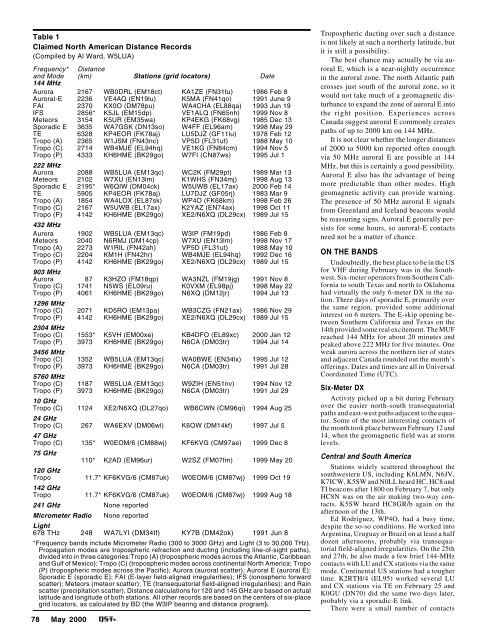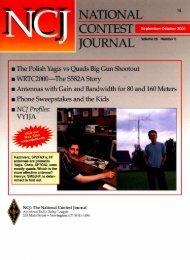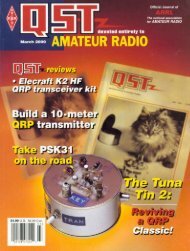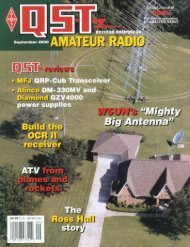Table 1Claimed North American Distance Records(Compiled by Al Ward, W5LUA)Frequency* Distanceand Mode (km) Stations (grid locators) Date144 MHzAurora 2167 WB0DRL (EM18ct) KA1ZE (FN31tu) 1986 Feb 8Auroral-E 2236 VE4AQ (EN19lu) K5MA (FN41qo) 1991 June 9FAI 2370 KX0O (DM78pu) WA4CHA (EL88qa) 1993 Jun 19IFS 2856* K5JL (EM15dp) VE1ALQ (FN65nh) 1999 Nov 8Meteors 3154 K5UR (EM35wa) KP4EKG (FK68vg) 1985 Dec 13Sporadic E 3635 WA7GSK (DN13so) W4FF (EL96am) 1998 <strong>May</strong> 29TE 6328 KP4EOR (FK78aj) LU5DJZ (GF11lu) 1978 Feb 12Tropo (A) 2365 W1JSM (FN43nc) VP5D (FL31ut) 1988 <strong>May</strong> 10Tropo (C) 2714 WB4MJE (EL94hq) VE1KG (FN84cm) 1994 Nov 5Tropo (P) 4333 KH6HME (BK29go) W7FI (CN87ws) 1995 Jul 1222 MHzAurora 2088 WB5LUA (EM13qc) WC2K (FM29pt) 1989 Mar 13Meteors 2102 W7XU (EN13lm) K1WHS (FN34mj) 1998 Aug 13Sporadic E 2195* W6QIW (DM04ck) W5UWB (EL17ax) <strong>2000</strong> Feb 14TE 5905 KP4EOR (FK78aj) LU7DJZ (GF05rj) 1983 Mar 9Tropo (A) 1854 WA4LOX (EL87sk) WP4O (FK68km) 1998 Feb 26Tropo (C) 2167 W5UWB (EL17ax) K2YAZ (EN74ax) 1998 Oct 11Tropo (P) 4142 KH6HME (BK29go) XE2/N6XQ (DL29cx) 1989 Jul 15432 MHzAurora 1902 WB5LUA (EM13qc) W3IP (FM19pd) 1986 Feb 8Meteors 2040 N6RMJ (DM14cp) W7XU (EN13lm) 1998 Nov 17Tropo (A) 2273 W1RIL (FN42ah) VP5D (FL31ut) 1988 <strong>May</strong> 10Tropo (C) 2204 KM1H (FN42hr) WB4MJE (EL94hq) 1992 Dec 16Tropo (P) 4142 KH6HME (BK29go) XE2/N6XQ (DL29cx) 1989 Jul 15903 MHzAurora 87 K3HZO (FM18qp) WA3NZL (FM19jg) 1991 Nov 8Tropo (C) 1741 N5WS (EL09ru) K0VXM (EL98pj) 1998 <strong>May</strong> 22Tropo (P) 4061 KH6HME (BK29go) N6XQ (DM12jr) 1994 Jul 131296 MHzTropo (C) 2071 KD5RO (EM13pa) WB3CZG (FN21ax) 1986 Nov 29Tropo (P) 4142 KH6HME (BK29go) XE2/N6XQ (DL29cx) 1989 Jul 152304 MHzTropo (C) 1553* K5VH (EM00xe) KB4DFO (EL89xc) <strong>2000</strong> Jan 12Tropo (P) 3973 KH6HME (BK29go) N6CA (DM03tr) 1994 Jul 143456 MHzTropo (C) 1352 WB5LUA (EM13qc) WA0BWE (EN34lx) 1995 Jul 12Tropo (P) 3973 KH6HME (BK29go) N6CA (DM03tr) 1991 Jul 285760 MHzTropo (C) 1187 WB5LUA (EM13qc) W9ZIH (EN51nv) 1994 Nov 12Tropo (P) 3973 KH6HME (BK29go) N6CA (DM03tr) 1991 Jul 2910 GHzTropo (C) 1124 XE2/N6XQ (DL27qo) WB6CWN (CM96qi) 1994 Aug 2524 GHzTropo (C) 267 WA6EXV (DM06wl) K6OW (DM14kf) 1997 Jul 547 GHzTropo (C) 135* W0EOM/6 (CM88wj) KF6KVG (CM97ae) 1999 Dec 875 GHz110* K2AD (EM96ur) W2SZ (FM07fm) 1999 <strong>May</strong> 20120 GHzTropo 11.7* KF6KVG/6 (CM87uk) W0EOM/6 (CM87wj) 1999 Oct 19142 GHzTropo 11.7* KF6KVG/6 (CM87uk) W0EOM/6 (CM87wj) 1999 Aug 18241 GHz None reportedMicrometer Radio None reportedLight678 THz 248 WA7LYI (DM34tf) KY7B (DM42ok) 1991 Jun 8*Frequency bands include Micrometer Radio (300 to 3000 GHz) and Light (3 to 30,000 THz).Propagation modes are tropospheric refraction and ducting (including line-of-sight paths),divided into in three categories:Tropo (A) (tropospheric modes across the Atlantic, Caribbeanand Gulf of Mexico); Tropo (C) (tropospheric modes across continental North America; Tropo(P) (tropospheric modes across the Pacific); Aurora (auroral scatter); Auroral E (auroral E);Sporadic E (sporadic E); FAI (E-layer field-aligned irregularities); IFS (ionospheric forwardscatter); Meteors (meteor scatter); TE (transequatorial field-aligned irregularities); and Rainscatter (precipitation scatter). Distance calculations for 120 and 145 GHz are based on actuallatitude and longitude of both stations. All other records are based on the centers of six-placegrid locators, as calculated by BD (the W3IP bearing and distance program).78 <strong>May</strong> <strong>2000</strong>Tropospheric ducting over such a distanceis not likely at such a northerly latitude, butit is still a possibility.The best chance may actually be via auroralE, which is a near-nightly occurrencein the auroral zone. The north Atlantic pathcrosses just south of the auroral zone, so itwould not take much of a geomagnetic disturbanceto expand the zone of auroral E intothe right position. Experiences acrossCanada suggest auroral E commonly createspaths of up to <strong>2000</strong> km on 144 MHz.It is not clear whether the longer distancesof <strong>2000</strong> to 5000 km reported often enoughvia 50 MHz auroral E are possible at 144MHz, but this is certainly a good possibility.Auroral E also has the advantage of beingmore predictable than other modes. Highgeomagnetic activity can provide warning.The presence of 50 MHz auroral E signalsfrom Greenland and Iceland beacons wouldbe reassuring signs. Auroral E generally persistsfor some hours, so auroral-E contactsneed not be a matter of chance.ON THE BANDSUndoubtedly, the best place to be in the USfor VHF during February was in the Southwest.Six-meter operators from Southern Californiato south Texas and north to Oklahomahad virtually the only 6-meter DX in the nation.Three days of sporadic E, primarily overthe same region, provided some additionalinterest on 6 meters. The E-skip opening betweenSouthern California and Texas on the14th provided some real excitement. The MUFreached 144 MHz for about 20 minutes andpeaked above 222 MHz for five minutes. Oneweak aurora across the northern tier of statesand adjacent Canada rounded out the month’sofferings. Dates and times are all in UniversalCoordinated Time (UTC).Six-Meter DXActivity picked up a bit during Februaryover the easier north-south transequatorialpaths and east-west paths adjacent to the equator.Some of the most interesting contacts ofthe month took place between February 12 and14, when the geomagnetic field was at stormlevels.Central and South AmericaStations widely scattered throughout thesouthwestern US, including K6LMN, N6JV,K7ICW, K5SW and N0LL heard HC, HC8 andTI beacons after 1800 on February 7, but onlyHC8N was on the air making two-way contacts.K5SW heard HC8GR/b again on theafternoon of the 13th.Ed Rodriguez, WP4O, had a busy time,despite the so-so conditions. He worked intoArgentina, Uruguay or Brazil on at least a halfdozen afternoons, probably via transequatorialfield-aligned irregularities. On the 25thand 27th, he also made a few brief 144-MHzcontacts with LU and CX stations via the samemode. Continental US stations had a toughertime. K2RTH/4 (EL95) worked several LUand CX stations via TE on February 25 andK0GU (DN70) did the same two days later,probably via a sporadic-E link.There were a small number of contacts
from South America to southwestern Europeon a half-dozen afternoons during the secondhalf of the month, mostly LU, CX and PY toEH and EH8, according to Nestor Zucchi,LW5EJU and others. Highlights includedZP5RPO to EH and EH8 and PY2XB to9H1AW on February 18. CE3SAD had a QSOwith EH7KW on the 21st, for his first everEuropean. LW5EJU worked CN8LI on the22nd and IK5RLP on the 26th. WP4O foundEH7KW on the 15th and both WP4O andKP4EIT made a weak skewed scatter-pathcontact with EH3ADW on the 26th.The PacificUS stations from Southern California tosouth Texas, including K6LMN, K7JA/6 andW5UWB worked New Zealand on the afternoonsof February 7, 8 and 13. K5CM andK5SW, both in eastern Oklahoma, caught upwith the ZLs on the 13th. It was the first timeK5SW had worked New Zealand since the lastcycle. Roman Flores, XE2EED, also workedNew Zealand on the eighth and found a halfdozen Australians on the 14th. K7JA/6 wassurprised to work VK4FNQ after 0702 thesame day—that is after 11:00 PM local time!Perhaps the most unusual contacts from theUS across the Pacific were made on February13. “Smitty” Smith, W4UDH (EM52) in Mississippi,and others in the southerly EM gridsworked YJ8UU in Vanuatu after 0150. Threehours later, VP6BR on Pitcarin Island hookedup with HK3YK and possibly others inPanama and Mexico. VP6BR made a greaterstir on February 16 around 2340 when heworked EH7KW and EH8BPX.Japanese operators made some impressivecontacts during the month, according toHatsuo Yoshida, JA1VOK. Highlights aresummarized in Table 2.7J6CCU started the February 28 excitementbetween 0025 and 0035, when he workedCT3HF and EH8BYR via the long path. OtherJapanese stations quickly made the grade aswell for the first-ever series of JA-EH8 contacts.LW5EJU found CE0Y/UA6AF on EasterIsland at 0058 and then JH7MSB at 0137.Africa and the Indian OceanStations widely scattered throughout theMediterranean basin, along with a few othersas far north as Germany, worked into southernAfrica and adjacent Indian Ocean on severaldays of the month. Prominent among the Africanand Indian Ocean calls were 5H3US,8Q7QQ, FR1AN, V51KC, Z21FO, Z22JE andmany ZS stations.Sporadic EThere were 6-meter sporadic-E openingsacross the US only on February 12-13, 13-14and15. Even so, three openings is above averagefor the month—statistically one of thepoorest of the year. Much of the central part ofthe country was saturated with strong 6-meterE skip between 2200 and 0300 over February12-13. John Butrovich, W5UWB (EL17) insouth Texas, worked widely scattered stationsfrom Idaho to South Dakota, south to Tennesseeand Missouri, and as close as Kansas.Roger Wagner, K6LMN, also reported thatpaths got very short between south Texas andArizona, but no 2-meter contacts resulted.The openings the next afternoon also coveredlarge area. Larry Lambert, N0LL, in centralKansas ran W2, 3 and 8 call-area stationsTable 2Japanese 6-Meter DX “Bests” duringFebruaryDate Time Japan DX9 1329 JA1VOK VK9CO12 0345 JA3EGE CX4AAJ13 0805-0830 JA5, 6, JR6 8Q7QQ13 1035-1040 JR6 A45ZN14 0028-0034 JA1VOK KH617 1430-1500 JA (many) VQ9QM19 0813 JA1VOK UN3G20 0949 JR6 Z22JE21 1137-1200 JR6 FR1ANafter 2150 on February 13 for nearly anhour. Jim Stewart, WA4MVI worked intoLouisiana from his South Carolina location.Pat Dyer, WA5IYX, and others in south Texasfound many strong stations from SouthernCalifornia and Mexico. On the 15th, the actionshifted to the Pacific Northwest and southto Southern California.Although these 6-meter openings were theusual single-hop affairs, the February 13-14event would have been exceptional wheneverit took place. WA5IYX (EL09) watched theMUF move through the lower TV channelsand into the FM band after 0000 on the 14th.Then at about 0130, the MUF shot through144 MHz. For 20 minutes, WA5IYX,W5UWB, KM5RG and at least half a dozenothers in south Texas found K7JA/6,WB6NOA and several more Californians on 2meters.W5UWB topped off this excitement withtwo exceptional 222 MHz contacts. After aquick 144 MHz contact with N6HKF (DM13),the pair completed at 0135 on 222 MHz. Thiswas surely a 222-MHz E-skip record, but itlasted no more than five minutes. At 0140,W5UWB duplicated the feat with W6QIW(DM04) over a 2195 km path for a new 222MHz sporadic-E record. An attempt to make itwith K6IBY (DM13) around 0138 failed dueto QRM.AuroraThe geomagnetic field reached storm conditionson several days during February, butrarely during the late afternoon times that areprime time for aurora over North America.Only the aurora on the evening of February 12(0045 to 0300) produced significant propagation.John Feltz, W9JN (EN54), made 36QSOs on 50, 144 and 222 MHz, but all werelimited to latitudes north of EN50 in northernIllinois. KM0T (EN13) hooked up with N7EIJ(DN17) for a 1700-km contact on 144 MHz,but this too was at a relatively high latitude.NOTES FROM ALL OVEREME From the Polar RegionsKimio Maegawa (JA9BOH) operated2-meter EME as 8J1RL from Showa Station,Antarctica, between last October and January.Despite the obvious difficulties of his location,Kimio completed 59 QSOs with 49 differentstations. He used an FT-736 as the basicrig, a brick amplifier at relatively low powerand various two-Yagi arrays.Not surprisingly, many of the 2-meterEME big guns were among the first 10 in hislog, including W5UN, KB8RQ, SM2CEW,SM5BSZ, I2FAK, HB9Q and SM7BAE.Many of his QSOs were made in response toCQs. Kimio provided many with a new countryand a new continent, but he was not thefirst to operate 2-meter EME from Antarctica.K6MYC operated from an American baseduring December 1994.More polar EME activity is planned forearly June. A group of 25 Danish operatorsplan to operate OX2K from Greenland between<strong>May</strong> 29 and June 6. They will be on144, 432 and 1296 EME, as well as 6 metersand the HF bands. The 144 and 432 MHz EMEstations will run 1500 W into arrays of fourlong Yagis each. On 1296 MHz, the grouphopes to use an existing huge dish, which itmust share with other services. Look for moreinformation at www.qsl.net/ox2k.Getting Started on 47 GHzAre you ready for the 6-mm band? TheRadio Society of Great Britain MicrowaveNewsletter recommends several Web pageswith 47-GHz information. Check out www.g3pho.free-online.co.uk, www.geocities.com/SiliconValley/Vista/8063 and http://www.mm-wave.demon.co.uk/radio.htm.VHF/UHF/MICROWAVE NEWSHigh-Speed Meteor-Scatter ContestSteve Harrison, K0XP/1, announces theThird Annual North American HSMS Contest,which runs the entire UTC days of April29 through <strong>May</strong> 7. The minor eta Aquaridsmeteor shower occurs during this time. Operatea maximum of 48 hours in 30-minute minimumblocks. Listening time counts as operating.Make contacts on any band above 50 MHzusing CW speeds of at least 99 WPM. Scoringand other rules are a bit complicated, so sendan e-mail to Steve at ko0u@os.com and viewlog and summary sheets at www.qsl.net/n7stu/hscw.html.CQ Spring VHF Activity WeekendsCQ magazine (which absorbed CQ-VHFthis past January) sponsors three differentVHF activity weekends based on transmissionmodes. April 28-30 is devoted to CW, SSBand all digital modes that occupy no greaterbandwidth than an SSB signal. <strong>May</strong> 19 to 21is for video, RTTY, AMTOR, packet and otherwide-band digital modes. (News of the March17-19 FM activity weekend arrived too latefor the March column.)Each weekend is divided into nine six-hourperiods beginning 6:00 PM Friday and endingmidnight Sunday local time. Work a stationonce per band (regardless of transmissionmode) during each time period, for a maximumof nine times. Satellite contacts are permittedduring the April 28-30 weekend. Forfurther details on scoring, entry classificationsand other rules, see CQ for February.<strong>May</strong> <strong>2000</strong> 79
- Page 6 and 7:
May 2000 Volume 84 Number 5David S
- Page 11 and 12:
THE AMERICAN RADIORELAY LEAGUE INC
- Page 14:
Get to Know Your Section ManagerThe
- Page 18:
The ARRL and the FCC’s Private Wi
- Page 22 and 23:
The postman always keys twice.Accor
- Page 26 and 27:
CORRESPONDENCEYour opinions count!
- Page 30 and 31: By Ian Poole, G3YWXOperating in the
- Page 32 and 33: By Roger Sullivan, WA0ETE, and Hugh
- Page 34 and 35: By Jim Graver, KB8PSO2000Dayton Ham
- Page 36 and 37: Figure 1A—Schematic of the interf
- Page 38 and 39: All input/output connections are ma
- Page 40 and 41: Figure 4—Hanger loopconstruction.
- Page 42 and 43: Figure 2—A GOES-8 picture capture
- Page 44 and 45: By Steve Ford, WB8IMYPSK31 2000In e
- Page 46 and 47: the software, PSK31 tuning required
- Page 48 and 49: WORKBENCHPROJECTS AND INFORMATION F
- Page 50 and 51: By Martin A. Minow, K6MAMPractice M
- Page 52 and 53: the download to a suitable location
- Page 54 and 55: 52 May 2000SHORT TAKESHeil Sound Go
- Page 56 and 57: By Zack Lau, W1VTA No-Tune 2-Meter
- Page 58 and 59: HINTS & KINKSA FOLD-DOWN MOBILE-ANT
- Page 60 and 61: By James Kates, N9GBBConfessions of
- Page 62 and 63: PRODUCT REVIEWKenwood TM-D700A Dual
- Page 64 and 65: is accomplished by using OK, BACK a
- Page 66 and 67: other radio operation. The chatter
- Page 68 and 69: operation because there’s so litt
- Page 70 and 71: consideration in the WT Docket 98-1
- Page 72 and 73: News in Brief:• League members no
- Page 74 and 75: communications tests in celebration
- Page 76 and 77: I’ve done this tour several years
- Page 78 and 79: The Crystal Symphony at anchor off
- Page 82 and 83: Okay in My LogBy Vic Curtis,WA3YUVP
- Page 84 and 85: their 432 MHz triumph of the previo
- Page 86 and 87: 2000 ARRL Field DayRulesBy Dan Hend
- Page 88 and 89: Collecting Vintage QSLsOLD RADIOAn
- Page 90 and 91: DIGITAL DIMENSIONAPRS Digipeater in
- Page 92 and 93: AT THE FOUNDATIONWhy We Fund Museum
- Page 94 and 95: It is with deep regret that we reco
- Page 96 and 97: COMING CONVENTIONSARRL NATIONAL CON
- Page 98 and 99: checking; handicapped accessible; f
- Page 106: of the West Allis ARC and served as
- Page 110: introduced that could of had a bear
- Page 114: 211/109; NJN/L 29/203/103; CJTN 29/
- Page 118: W1PEX 1048, WA1JVV 143, N1NH 105, W
- Page 124: an activity we enjoy so much can be
- Page 128: 126He is President of the Amateur R
- Page 132:
is Walt Bacon, N6SMT, who is curren
- Page 150:
Ham Adsl) Advertising must pertain
- Page 154:
BAHAMAS RENTAL: Abaco villa w/stati
- Page 164:
“EVERYTHING FOR THE MORSE ENTHUSI
- Page 168:
TUBES WANTED: Highest prices paid o
















